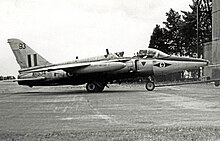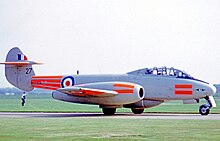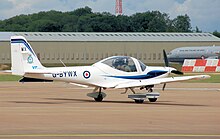Central Flying School
This article's lead section may be too short to adequately summarize the key points. (November 2010) |
| Central Flying School CFS | |
|---|---|
| Active | 12 May 1912 – present |
| Country | |
| Branch | |
| Type | Training |
| Role | RAF flying training |
| Size | 100 personnel |
| Garrison/HQ | RAF Upavon, Wiltshire England 1912–46 RAF Little Rissington, Gloucestershire England 1946–1976 |
| Nickname(s) | RAF CFS |
| Motto(s) | Imprimis Praecepta (Template:Lang-la) |
| Commanders | |
| Commandant | Group Captain Fin Monahan |
The Central Flying School (CFS) is the Royal Air Force's primary institution for the training of military flying instructors. Established in 1912, it is the longest existing flying training school. Its motto is Imprimis Praecepta which is Latin for "Our Teaching is Everlasting" and its Mission Statement is 'To Deliver, Develop and Assure Excellence in Aircrew Instruction for Defence'.
History


It was established at Upavon Aerodrome, near Upavon, Wiltshire on 12 May 1912.[1] It was later based at RAF Little Rissington, from 1946 to 1976. The CFS's first commandant was Captain Godfrey Paine RN. It has been responsible for instructor training since 1920, with pilot training being delegated to the Flying Training Schools.
Display teams
When the Red Arrows, the RAF's sole aerobatic team was formed by amalgamation of other teams, the responsibility was transferred to the CFS from Fighter Command. The Red Arrows moved to RAF Scampton in 1983 when the CFS was moved there and out in 1995– though the Red Arrows returned in 2000.
Elementary flying training
The section started using de Havilland Chipmunk T.10 and Scottish Aviation Bulldog T.1.[2]
In 2000 the Grob Tutor T.1 replaced the Scottish Aviation Bulldog as the initial trainer operated by the unit.
Fast jet training
During the 1950s the CFS was equipped with the Gloster Meteor. During 1976 the Hawker Siddeley Gnat T.1s were based at RAF Valley however during 1977 these were replaced as the CFS main advanced jet trainer by the Hawker Siddeley Hawk T.1.
From 1993 the Short Tucano took the place of the BAC Jet Provost.
Helicopter training
Helicopter instruction began in 1955 on the Westland Dragonfly and Bristol Sycamore at RAF South Cerney in Gloucestershire. It moved to RAF Ternhill in August 1961. From 1966, the Westland-built Sioux helicopter began service, lasting until 1973, when replaced with the Westland Gazelle HT.2s, much more reminiscent of modern-day helicopters. During the 1970s the Westland Whirlwind HAR.10s were also used and the School had a detachment at RAF Valley, Anglesey, Wales for SAR and mountain rescue training.[3]
In 1997 the Gazelle HT.2's and HT.3's were replaced by the Squirrel (Eurocopter AS350), and the Griffin (Bell 412) is also used. RAF Shawbury has been the home of the helicopter training school since 1977, becoming the Defence Helicopter Flying School in 1997. A satellite unit of the CFS is maintained at RAF Shawbury to train and develop helicopter instructors.
Current Training Squadrons
All UK military aircrew start their flying careers with elementary flying training:
- Grob Tutor T.1 – (RAF Cranwell/RAF Barkston Heath)
- No. 16 (R) Squadron – Elementary Flight Training (EFT)
- No. 57 (R) Squadron – Elementary Flight Training (EFT)
- No. 115 (R) Squadron – training of QFI Instructors for EFT and UAS/AEF squadrons
Following EFT, aircrew students are streamed to either fast jet, rotary-wing or multi-engine pipelines.
Fast Jet

- Shorts Tucano T.1 – (RAF Linton-on-Ouse)
- 72(R) Squadron – Basic Fast Jet Training (BFJT)
- BAe Systems Hawk T.2 – (RAF Valley)
- 4(R) Squadron – Advanced Fast Jet and Tactics Training
Following Fast Jet training, successful students go on to the Typhoon or Tornado GR4.
Multi Engine
- Beechcraft King-Air T.1 – (RAF Cranwell)
- No. 45 (R) Squadron RAF – Multi-Engine training
Multi Engine students will go on to fly the C-17, Atlas, Hercules or Voyager transport aircraft or ISTAR assets like the Shadow, Sentry, Sentinel or Rivet Joint.
Rotary Wing
Defence Helicopter Flying School
- Squirrel HT.1 – (RAF Shawbury)
- 660 Squadron Army Air Corps – basic single-engine helicopter training: 660 AAC and 705 NAS take alternate intakes from all three services
- 705 Naval Air Squadron
- Griffin HT.2 – (RAF Shawbury)
- 60(R) Squadron – Advanced Helicopter training to RAF crews
Rotary wing students stream onto the Chinook or the Puma HC.2.
Future System
Under the new UK Military Flying Training System, provided by Ascent Flight Training, a consortium of Lockheed Martin and Babcock International, new aircraft will be procured for the pipeline:[4]
- Elementary Flying Training: Grob G120TP, replacing the Tutor T.1 based at RAF Cranwell/RAF Barkston Heath
- Basic Fast Jet Training: Beechcraft T-6 Texan II, replacing the Tucano T.1, moving to RAF Valley
- Advanced Fast Jet Training: BAe Hawk T.2, already in service at RAF Valley
- Multi-Engine Training: Embraer Phenom 100, replacing the Beechcraft King Air T.1 at RAF Cranwell
Training

Suitable pilots are trained as Qualified Flying Instructor (QFIs) on the Grob Tutor and the Beechcraft King Air at RAF College Cranwell. Tucano QFIs are trained by CFS personnel at RAF Linton-on-Ouse and Hawk QFIs are trained by similar personnel at RAF Valley. Helicopter instructors, both pilots and rearcrew, are trained at RAF Shawbury, home of the Defence Helicopter Flying School.
Flying instructors are awarded the Qualified Flying Instructor qualification for fixed-wing types. Helicopter instructors are referred to as Qualified Helicopter Instructors (QHI) or Qualified Helicopter Crewman Instructors (QHCI).
Commandants

Ranks given are the highest rank the officer in command held during his tenure.
1912 to 1919
- 19 June 1912 Captain G M Paine RN
- 15 November 1915 Lieutenant-Colonel D le G Pitcher
- 1 February 1916 Colonel C J Burke[5]
- 18 June 1916 Lieutenant-Colonel A C H MacLean
- 1917 Lieutenant-Colonel A J L Scott[6]
1919 to 1920 (as Commandant, Flying Instructors' School)
- 17 January 1919 Lieutenant-Colonel P H L Playfair
- 7 April 1919 Lieutenant-Colonel (later Wing Commander) C D Breese
1920 to 1944
- 3 May 1920 Wing Commander Norman MacEwen
- 1922 Air Commodore Edward Masterman
- 1 January 1923 Group Captain Felton Holt
- 22 April 1925 Group Captain Wilfrid Freeman
- 24 January 1927 Group Captain (later Air Commodore) C S Burnett
- 17 December 1928 Wing Commander (later Group Captain) J E A Baldwin
- 19 January 1932 Group Captain Paul Maltby
- July 1935 Wing Commander (later Group Captain) Harry George Smart
- 14 December 1936 Group Captain James Robb
- 17 March 1940 Group Captain Harold Down
- 1944 Claude Vincent
1946 to present
This section needs expansion. You can help by adding to it. (June 2008) |
- 1951 Anthony Selway
- 1961 Hugh Connolly
- 1963 Harold Bird-Wilson
- 1968 Ivor Broom
- 1970 Freddie Hazlewood[7]
- 1974 John Severne
- 1983 John Kemball
- 1985 Air Commodore Allan Blackley
- Air Commodore David Leppard
- 1994 Air Commodore Simon Bostock
- 1996 Air Commodore Gavin Mackay
- 2007 Group Captain Nick Seward
- 2009 Group Captain Simon Blake
- 2012 Group Captain David Bentley
- 2014 Group Captain Jamie Hunter
- 2016 Group Captain Fin Monahan
Assistant Commandants
- 1912 Lieutenant Colonel Henry Cook[8]
- 23 September 1913 Lieutenant Colonel Hugh Trenchard[9][10]
- 7 August 1914 Major, later Lieutenant Colonel, Tom Webb-Bowen[11][12]
- 6 March 1915 Lieutenant Colonel D Le G Pitcher[13]
Notable former instructors
- Air Marshal Sir Richard Atcherley (1925–28)
- Air Marshal Sir Lawrence Pendred (1924–30)
- Air Chief Marshal Sir James Robb (1927–30)
- Air Chief Marshal Sir Rex Roe (1953–55)
- Marshal of the Royal Air Force Sir John Salmond (1912)
- Air Marshal Sir Anthony Selway (1932–34)
- Air Vice-Marshal Sir Tom Webb-Bowen (1912–15)
See also
References
- Citations
- ^ Lake 1999, p. 44.
- ^ Thetford 1995, p. 398.
- ^ Green 1976, p. 13.
- ^ "News & Press". Ascent Flight Training. Retrieved 14 July 2015.
- ^ http://www.flightglobal.com/pdfarchive/view/1916/1916%20-%200134.html
- ^ http://www.raf.mod.uk/history_old/cfscommen1.html
- ^ Obituary in Telegraph
- ^ http://www.flightglobal.com/pdfarchive/view/1912/1912%20-%200776.html
- ^ http://www.rafweb.org/Biographies/Trenchard.htm
- ^ "No. 28873". The London Gazette. 18 August 1914. p. 6496.
- ^ http://www.rafweb.org/Biographies/Webb-Bowen.htm
- ^ "No. 28901". The London Gazette (Supplement). 11 September 1914. p. 7284.
- ^ "No. 29094". The London Gazette. 9 March 1915. p. 2368.
- Bibliography
- Green, W; Swanborough, G (1976). Royal Air Force Yearbook 1976. Bromley: Royal Air Force Benevolent Fund.
- Lake, A (1999). Flying units of the RAF. Shrewsbury: Airlife. ISBN 1-84037-086-6.
{{cite book}}: CS1 maint: ref duplicates default (link) - Taylor, John W R (1987) [1958]. Central Flying School, Birthplace of Air Power. Jane's Publishing. ISBN 0-7106-0486-6.
- Thetford, O (1995). Aircraft of the Royal Air Force since 1918. London, UK: Putnam Aeronautical Books. ISBN 0-85177-865-8.
{{cite book}}: CS1 maint: ref duplicates default (link)
